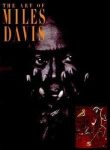 Miles Davis takes up a lot of room on my shelves. His autobiography sits among my books. His music proliferates among the cassettes and LPs and CDs. I’ve got a couple of VHS tapes kicking about somewhere, stuff I recorded off the telly when he died, a Live in Paris concert. The film Ascenseur pour l’échafaud, for which Miles created the soundtrack, sits between À bout de souffle and Diva among the DVDs.
Miles Davis takes up a lot of room on my shelves. His autobiography sits among my books. His music proliferates among the cassettes and LPs and CDs. I’ve got a couple of VHS tapes kicking about somewhere, stuff I recorded off the telly when he died, a Live in Paris concert. The film Ascenseur pour l’échafaud, for which Miles created the soundtrack, sits between À bout de souffle and Diva among the DVDs.
But this post takes its title from the one item that doesn’t fit on any of my shelves: The Art of Miles Davis. An outsized paperback edition that reproduces 70 odd drawings and paintings alongside an extended interview with the book’s editor. I ordered my copy from Waterstone’s in town, I think, when it still occupied the Ca’d’oro Building in Union Street, 1991. It’s great to see it again.
The book was a total revelation to me. I had been slowly broadening my appreciation of his music, mostly through cut price Fopp purchases (when they still occupied their original shop further up Renfield Street) and the occasional EK library borrowing. I wrote about how I got into Miles’s music, here, but this book acted as a gateway drug into another form of artistic expression entirely. It made a powerful connection between music and images. It made me want to make art.
From reading the interview with Miles in the book, I learned that he was influenced by Picasso and Kandinsky – names I’d heard, but didn’t know anything about, and which I subsequently set out to discover. I learned about African tribal art, and the influence that had on Miles’s painting. I started doing paintings of my own, out in the greenhouse, while listening to the murky funk of Miles’s mid 70s period, albums like Dark Magus and Get Up With It – which the Guardian describes as “a tremendously odd record, one that begins with a tribute to the just deceased Duke Ellington, a 32-minute piece of colossally-cool ambient space jazz” – perfect for creating the necessary conditions for the dreamy headspace needed for creating art.
Looking back at the book after many, many years, I’m struck by the vibrancy of the colours, the fluidity of movement. Robots mingle with dancers, faces peer out at you, figures stand and pose proud and indifferent. It doesn’t come to me as music, exactly, but there is a definite rhythmic quality to the compositions of many of them, and an improvisational element going on throughout. I’m drawn to the textures of the oil paintings as well as to his sinewy, figurative drawings. I can identify many techniques I’ve used myself – masking off areas with tape, gestural brushwork, scratching into the paint, I can immediately see Picasso and Kandinksy, also Klee and Rothko, a lot of abstract expressionism – a style I love, possibly because of this book.
